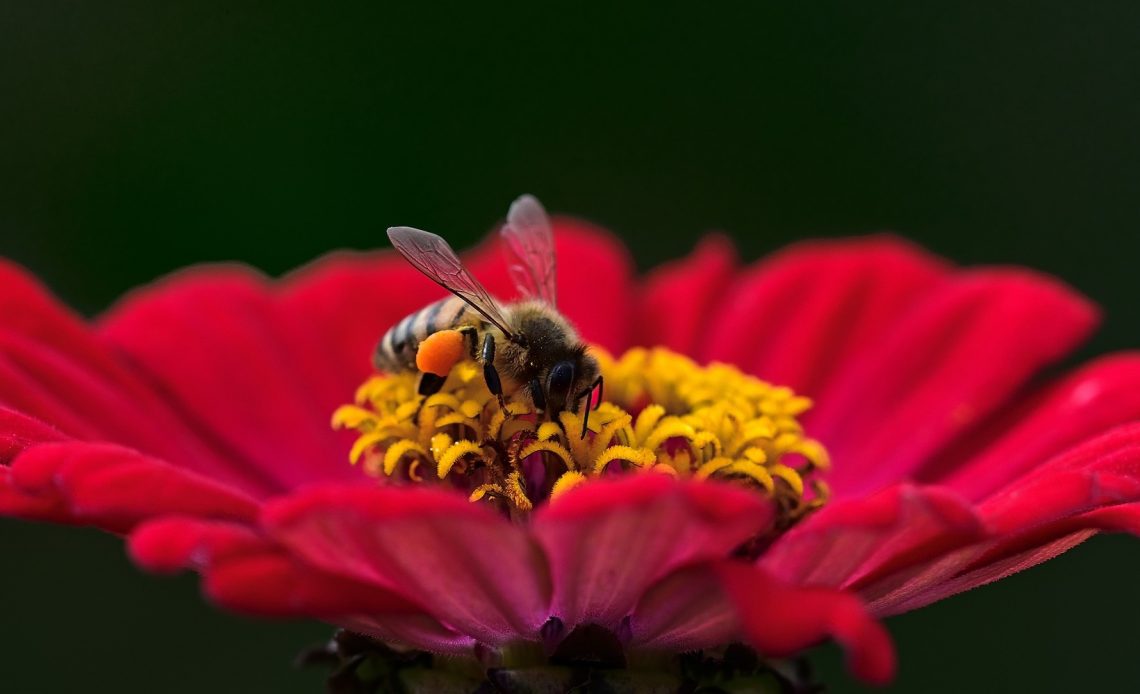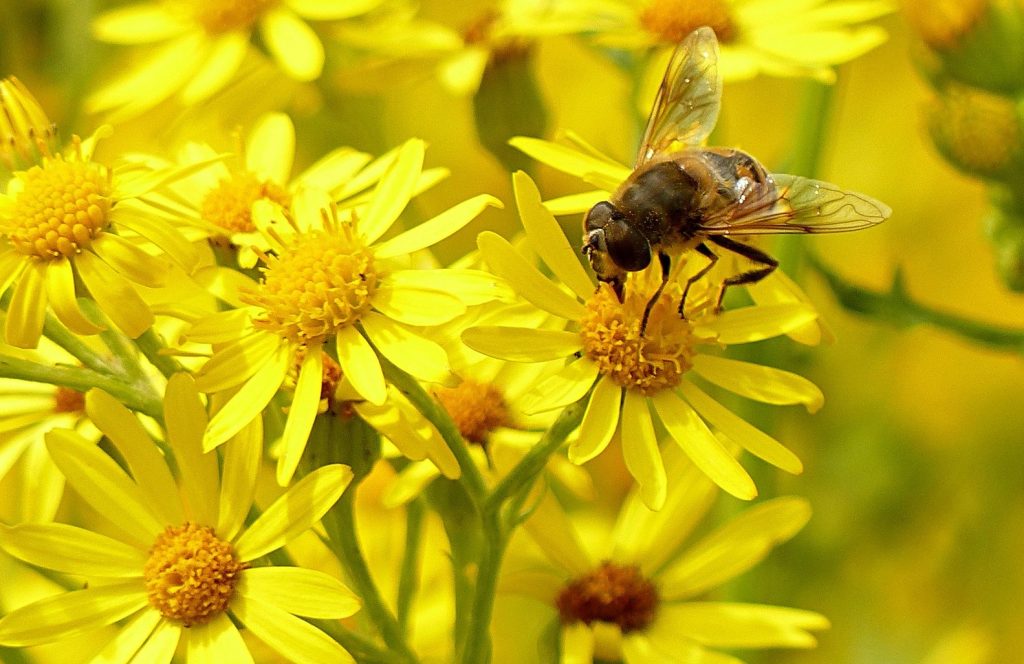

We’re here to help! Wild Yards is a completely free website that is 100% dedicated to helping you create a wildlife-friendly, sustainable yard. Read more
WildYards is reader-supported. When you buy a product through a link on our site, we may earn a comission. Every product is independently selected by our (obsessive) editors and our reviews are unbiased and objective. Read more about our mission or our privacy policy.
Bees are some of the hardest-working creatures in the animal kingdom – and they are fantastic at keeping our wild world looking and smelling wonderful. Therefore, it makes sense that so many people are keen to attract these buzzing little workhorses into their gardens and backyards. If you’re starting to learn how to attract bees to your garden, there are a few points you need to keep in mind.
To attract bees to your garden, simply make sure you have lots of accessible sources of nectar and pollen, and ensure that your yard is safe for them to come back to time and time again.
Of course, this is just the short answer – keep reading for an in-depth guide on how to make your garden a veritable paradise for bees.
Why should I attract bees to my garden?
Bees are fantastic for the ecosystem. While there are many different species and varieties of bees, they all work for the same purpose – to pollinate. That means that bees actively seek out nectar and pollen and help to ensure plants and crops grow naturally without our assistance.
Without bees, it is well documented that our food supplies would dwindle. That is not just going to affect people, but various wildlife, too. Losing bees to extinction could prove catastrophic – which is why it’s all the more important to give them a helping hand from day to day.
Beyond this, bees are delightful creatures that add to the atmosphere and color of a garden. Providing you don’t threaten them or cause them distress, they will peacefully live and work around your garden without any problems. By and large, they are not aggressive unless you pose a threat to their queens, either.
Types of bees to look out for
North America is home to many, many different species of bee. There are more than 4,000 bee species native to the US alone. However, you’ll likely welcome honey bees and mason bees most regularly of all.
As their names suggest, honey bees work hard to create honey in complex hives, where a single queen manages them. Other honey bees are drones and workers. They have short lifespans and work tirelessly to hunt down nectar and pollen. Their receptors are truly amazing – meaning if you have fragrant, colorful plants, they will likely come to you.
Mason bees don’t build hives but live in nests. They also tend to be some of the least threatening bee visitors, as the males don’t have any stingers. The females will only attack, too, if they are seriously threatened. It’s thought that more than 130 different mason bee species work across the US right now, and like honey bees, they are diligent at pollinating.
Bumblebees, meanwhile, aren’t necessarily spotted in all states, but they are still fairly common. They are sociable, fuzzy, and are superb pollinators. These are thick-bodied creatures that are perhaps the easiest of all bees to spot.
What are bees looking for from your garden?
To understand how to attract bees to your garden, it’s important to know what they are primarily looking for. Ultimately, this comes down to pollen and nectar. Bees thrive on both, and you’ll find them in many plants and flowers native to US soil.
In fact, native plants tend to work best with native bees! They have local tastes as they will generally flock to flowers that are familiar to them. However, it’s important to make sure that you grow a wide variety of different bee-friendly plants and flowers, in a palette of vibrant colors – and that smell fragrant!
On the whole, bees are looking for sweet treats. While they work hard, they know what they love to snack on, and many people love offering bees sugar and sugar water from time to time. However, to best pollinate your garden, it’s good to stick to arranging plants and flowers they’re sure to get natural sucrose from.
Essentially, bees are looking for a wild array of flowers and sucrose sources that they can rely on. Providing you grow a vibrant selection across the seasons, you will likely see regular visitors.
Did you also know that bees respond positively to vibrations, too? That’s largely because they communicate by creating such noises – and yes, there are popular songs out there that provide the buzzing frequencies to keep bringing bees back.
Things to avoid
The number one rule for attracting bees to your garden is to put down the pesticide and insecticides. Just because one branded bottle tells you that it will kill mosquitoes doesn’t mean it won’t harm bees. There are plenty of ways you can avoid harming bees in your garden – and it generally starts by leaving the chemical sprays in the cabinet.
If you have to or need to deter specific creatures from your backyard or garden, consider researching specific natural deterrents for the beasts in question. Don’t be afraid to get creative – did you know that woodpeckers are brilliant natural mosquito removers? It may be worth attracting woodpeckers to your yard as well as bees!
Do also be careful with sugar. As mentioned, some gardeners leave sucrose out for their bees, and sugar water can be handy in helping to revive fallen insects. That said, did you know that brown sugar is harmful to bees? Thanks to the added molasses, bee digestive systems struggle to process it – therefore, if you are going to leave sugar out for them, stick to pure, granulated sucrose.

Planting flowers bees love
On the whole, if a flower or plant is colorful and smells strongly enough, bees will want to come to them for nectar and pollen. A garden or yard that’s full to the brim with different flowers is very likely to be pollinated.
To get reliable waves of bee visitors into your garden or backyard, you’ll ideally need to focus on variety and diversity. Bees need varied diets to survive – and will be more interested in visiting a garden with lots of different nectar and pollen sources than, say, a garden that is purely full of sunflowers.
Bees also love different shapes and sizes of flowers and plants. It’s noted that trumpet-shaped flowers can be tricky for bees to get nectar from (and they prefer open-faced flowers), but if the scent is rich and the pollen is, too, your average bee is unlikely to turn down a meal.
Bees also seem to enjoy single flower varieties most of all – nice, open petals in a simple ring are easy to get pollen and nectar from.
Remember, however, that bees struggle to see the color red – so purples, yellows, oranges, blues, pinks, violets, and whites are all fantastic shades to plant across your garden.
Of course, bees can pollinate red flowers if they smell fragrant enough but stick to other colors where possible.
Beyond this, remember that bees tend to need a little shelter during bad weather. However, they adore sunlight, in which case, you need to find a balance between protective cover and sunny spots. Keeping your plants and flowers out in the open is a must, as bees of varying species are unlikely to head straight for the shade.
There are scores of different flowers that attract bees best of all – and honestly, learning all of the different types will probably take you a very long time!
Therefore, be sure to use the following list as a great starting point – these are all bee-friendly flowers and plants likely to keep your garden buzzing for months to come.
- Sunflowers
- Goldenrod
- Clematis
- Clover / Trifolium
- Snowberries
- Zinnias
- Alyssum
- Penstemons
- Lupines
- Black-eyed Susans / Rudbeckia
- Asters
- Hydrangeas (specifically Hydrangea paniculata)
- Daisies
- Rhododendrons
- Hyacinths
- Sage
- Butterfly weed / Asclepias
- Willow
- Star jasmine
- Bee balm / Monarda
- Oregon grapes
Do I need a beehive?
No, you don’t necessarily need a beehive for your garden or backyard, but you can set up a ‘home’ for them with minimal effort. You can easily make your own ‘bee house’ by drilling holes in wooden blocks or stacking them with holes in between.
However, you may find it easier to purchase a ready-made bee home to attach to a piece of fence or close to your bee-attracting flowers. The choice is yours!
What’s worth remembering is that not all bees live in hives. As mentioned, mason bees and bumblebees, commonly found in gardens across the US, build nests. Therefore, you’re helping these more solitary creatures by creating nesting boxes for them that they don’t have to put together themselves.
Do bees need water?
Bees certainly need to keep hydrated. Therefore, you’d be helping your local honey bees, in particular, by setting up a small watering station. A pail of water freshened up daily will go down a treat. Make sure bees can easily land and drink from the water, too, by adding a few floating corks to the surface.
Is it difficult to attract bees to a garden?
Attracting bees to your garden is extremely rewarding, though it will of course take some work. Not only do you need to consider how to get bees heading to your garden, you need to be careful of certain mishaps, too. For example, bees with damaged wings may need your care and support.
However, cultivating a bee-friendly garden can be as simple as making sure that you have a fantastic array of plants and flowers they are known to enjoy. Otherwise, providing you leave them to their business, they are unlikely to cause you any harm (even if they can sting through your clothes!). With a few careful, considerate touches, you could have a beautiful bee garden in no time at all.
